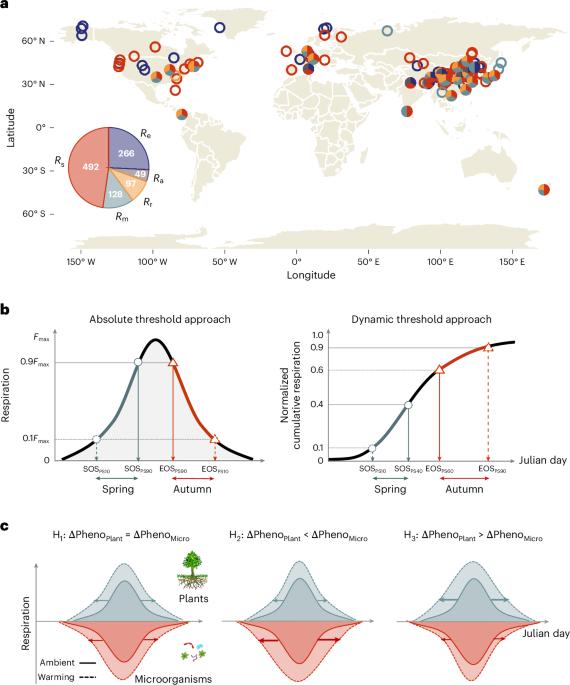土壤微生物和植物对气候变暖的不同物候响应
IF 16.1
1区 地球科学
Q1 GEOSCIENCES, MULTIDISCIPLINARY
引用次数: 0
摘要
人为的气候变暖正在改变全球各营养层的物候——生命周期事件的生物时间。然而,目前尚不清楚变暖是否会导致植物和土壤微生物物候的差异变化——这是陆地生物多样性和食物链的两个基本组成部分。本文基于1032个全球分布的植物和/或土壤微生物呼吸的物候变化响应实验变暖的观测结果,报告了气候变暖下植物和土壤微生物物候变化之间一致的不匹配。土壤微生物在春季物候学方面的进展和秋季物候学方面的延迟要大于植物芽和根,特别是在高植被(例如森林)下比在低植被(例如草原)下。此外,土壤微生物的物候变化在碳氮比高的土壤中,如在北方地区,比在碳氮比低的土壤中更大。这种植物与土壤微生物之间的物候不匹配可能会破坏它们的时间同步,使地上和地下的过程脱钩,并最终降低气候变暖下的能量流动和生态系统功能。本文章由计算机程序翻译,如有差异,请以英文原文为准。


Divergent phenological responses of soil microorganisms and plants to climate warming
Anthropogenic climate warming is altering phenology—the biological timing of life-cycle events—across trophic levels worldwide. However, it remains unclear whether warming induces differential changes in phenology between plants and soil microorganisms—two fundamental components of terrestrial biodiversity and food chains. Here we report a consistent mismatch between plant and soil microbial phenology under climate warming, on the basis of 1,032 globally distributed observations of phenological shifts in plant and/or soil microbial respiration in response to experimental warming. Advances in spring phenology and delays in autumn phenology are greater in soil microorganisms than in both plant shoots and roots, particularly under tall vegetation (for example, forests) compared with low vegetation (for example, grasslands). Furthermore, phenology shifts in soil microorganisms are greater in soils with high carbon-to-nitrogen ratios, such as those in boreal regions, than in those with lower ratios. Such phenological mismatches between plants and soil microorganisms could destabilize their temporal synchrony, decoupling above- and belowground processes, and ultimately degrading energy flow and ecosystem functioning under climate warming. Soil microorganisms are changing their phenology more than plants under climate warming, which could harm terrestrial ecosystem functioning, according to an analysis of a global compilation of experimental data.
求助全文
通过发布文献求助,成功后即可免费获取论文全文。
去求助
来源期刊

Nature Geoscience
地学-地球科学综合
CiteScore
26.70
自引率
1.60%
发文量
187
审稿时长
3.3 months
期刊介绍:
Nature Geoscience is a monthly interdisciplinary journal that gathers top-tier research spanning Earth Sciences and related fields.
The journal covers all geoscience disciplines, including fieldwork, modeling, and theoretical studies.
Topics include atmospheric science, biogeochemistry, climate science, geobiology, geochemistry, geoinformatics, remote sensing, geology, geomagnetism, paleomagnetism, geomorphology, geophysics, glaciology, hydrology, limnology, mineralogy, oceanography, paleontology, paleoclimatology, paleoceanography, petrology, planetary science, seismology, space physics, tectonics, and volcanology.
Nature Geoscience upholds its commitment to publishing significant, high-quality Earth Sciences research through fair, rapid, and rigorous peer review, overseen by a team of full-time professional editors.
 求助内容:
求助内容: 应助结果提醒方式:
应助结果提醒方式:


